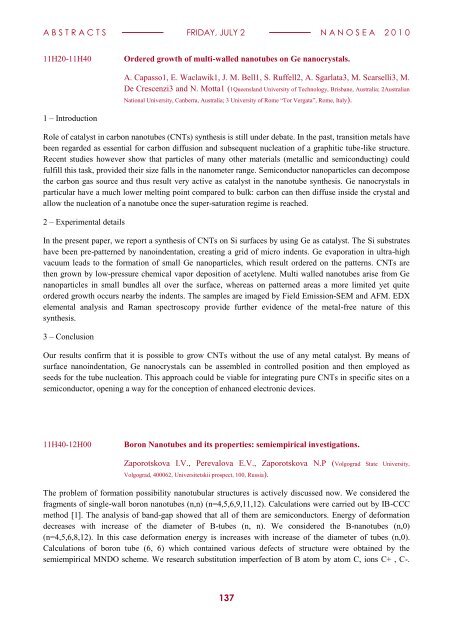book of abstracts - IM2NP
book of abstracts - IM2NP
book of abstracts - IM2NP
You also want an ePaper? Increase the reach of your titles
YUMPU automatically turns print PDFs into web optimized ePapers that Google loves.
A B S T R A C T S FRIDAY, JULY 2 N A N O S E A 2 0 1 0<br />
11H20-11H40<br />
Ordered growth <strong>of</strong> multi-walled nanotubes on Ge nanocrystals.<br />
A. Capasso1, E. Waclawik1, J. M. Bell1, S. Ruffell2, A. Sgarlata3, M. Scarselli3, M.<br />
De Crescenzi3 and N. Motta1 (1Queensland University <strong>of</strong> Technology, Brisbane, Australia; 2Australian<br />
National University, Canberra, Australia; 3 University <strong>of</strong> Rome “Tor Vergata”, Rome, Italy).<br />
1 – Introduction<br />
Role <strong>of</strong> catalyst in carbon nanotubes (CNTs) synthesis is still under debate. In the past, transition metals have<br />
been regarded as essential for carbon diffusion and subsequent nucleation <strong>of</strong> a graphitic tube-like structure.<br />
Recent studies however show that particles <strong>of</strong> many other materials (metallic and semiconducting) could<br />
fulfill this task, provided their size falls in the nanometer range. Semiconductor nanoparticles can decompose<br />
the carbon gas source and thus result very active as catalyst in the nanotube synthesis. Ge nanocrystals in<br />
particular have a much lower melting point compared to bulk: carbon can then diffuse inside the crystal and<br />
allow the nucleation <strong>of</strong> a nanotube once the super-saturation regime is reached.<br />
2 – Experimental details<br />
In the present paper, we report a synthesis <strong>of</strong> CNTs on Si surfaces by using Ge as catalyst. The Si substrates<br />
have been pre-patterned by nanoindentation, creating a grid <strong>of</strong> micro indents. Ge evaporation in ultra-high<br />
vacuum leads to the formation <strong>of</strong> small Ge nanoparticles, which result ordered on the patterns. CNTs are<br />
then grown by low-pressure chemical vapor deposition <strong>of</strong> acetylene. Multi walled nanotubes arise from Ge<br />
nanoparticles in small bundles all over the surface, whereas on patterned areas a more limited yet quite<br />
ordered growth occurs nearby the indents. The samples are imaged by Field Emission-SEM and AFM. EDX<br />
elemental analysis and Raman spectroscopy provide further evidence <strong>of</strong> the metal-free nature <strong>of</strong> this<br />
synthesis.<br />
3 – Conclusion<br />
Our results confirm that it is possible to grow CNTs without the use <strong>of</strong> any metal catalyst. By means <strong>of</strong><br />
surface nanoindentation, Ge nanocrystals can be assembled in controlled position and then employed as<br />
seeds for the tube nucleation. This approach could be viable for integrating pure CNTs in specific sites on a<br />
semiconductor, opening a way for the conception <strong>of</strong> enhanced electronic devices.<br />
11H40-12H00<br />
Boron Nanotubes and its properties: semiempirical investigations.<br />
Zaporotskova I.V., Perevalova E.V., Zaporotskova N.P (Volgograd State University,<br />
Volgograd, 400062, Universitetskii prospect, 100, Russia).<br />
The problem <strong>of</strong> formation possibility nanotubular structures is actively discussed now. We considered the<br />
fragments <strong>of</strong> single-wall boron nanotubes (n,n) (n=4,5,6,9,11,12). Calculations were carried out by IB-CCC<br />
method [1]. The analysis <strong>of</strong> band-gap showed that all <strong>of</strong> them are semiconductors. Energy <strong>of</strong> deformation<br />
decreases with increase <strong>of</strong> the diameter <strong>of</strong> B-tubes (n, n). We considered the B-nanotubes (n,0)<br />
(n=4,5,6,8,12). In this case deformation energy is increases with increase <strong>of</strong> the diameter <strong>of</strong> tubes (n,0).<br />
Calculations <strong>of</strong> boron tube (6, 6) which contained various defects <strong>of</strong> structure were obtained by the<br />
semiempirical MNDO scheme. We research substitution imperfection <strong>of</strong> B atom by atom C, ions С+ , С-.<br />
137

















